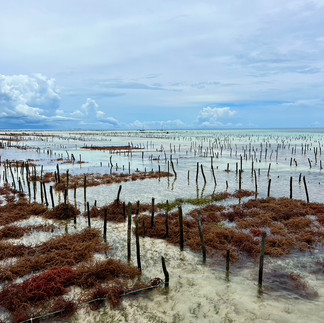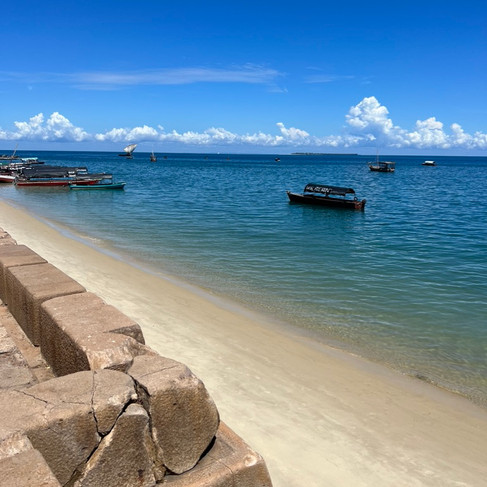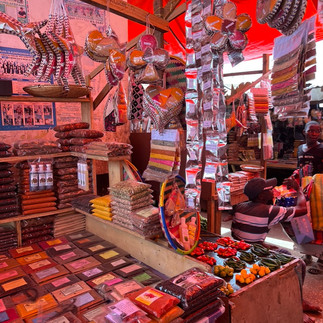Travel to Zanzibar, the island of colors and spices
- Vanessa Valenti

- Sep 10, 2023
- 20 min read
Updated: Dec 27, 2023
Zanzibar Island, called Unguja in Swahili, is the main island of the Zanzibar archipelago, located in the Indian Ocean just 20 km from the coast, in Tanzania. Zanzibar is a wonderful island and I remember very well the entire trip I took there 19 years ago together with my family: I have always had splendid memories of that holiday in which I fell madly in love with this island... so we couldn't really miss the opportunity to spend a few days there during our stay in Tanzania. Zanzibar is a perfect destination because even though it is an island of modest size, there are so many things to do: turquoise and crystalline waters, sand banks and small almost deserted islands, spice plantations, the splendid Stone Town, the forest and so many water activities... in short, in Zanzibar there is something for all tastes.
Zanzibar is part of the Republic of Tanzania but has its own government and parliament; the population is predominantly Muslim but there are also Catholics and Hindus. The language spoken by the inhabitants of Zanzibar is Swhaili but many speak Italian due to the many tourists coming from Italy.

How to get to Zanzibar
Zanzibar is a rather simple destination to reach: in fact, on the island there is one of the 3 international airports in Tanzania and it is well connected to Europe, being a highly sought-after tourist destination.
Flying to Zanzibar

We reached Zanzibar by taking internal flights from Mwanza: we booked online a couple of weeks before departure using the company Air Tanzania.
The journey was a bit long as there is no direct flight Mwanza - Zanzibar and we had to stop in Dar Es Salaam (the capital) spending €199 each with 23 kg of luggage included. Friday afternoon MWN - DAR (1h45min), DAR - ZNZ (30min) Monday evening ZNZ - DAR (30min), DAR - MWZ (1h30min) If you want to reach Zanzibar from Europe or other continent outside from Africa I can suggest you consider flying with Neos since they have direct flights at excellent prices.
Anyway.. Zanzibar Island has its own international airport so getting here is very simple and often quite cheap! Always check on Skyscanner for the best option!
Don't miss the other insights relating to my trip to Tanzania:
Visa for Zanzibar
To enter Zanzibar you need to pay and show a visa that costs $50 and is valid for 90 days: the payment must be made by credit card and you can pay directly upon arrival at the airport by handing in a form to be filled in and delivered to the immigration desk (the form is distributed in flight).
If you are not very familiar with all this documentation and bureaucracy, my advice is to entrust yourself to an agency that takes care of the visa procedure for you. iVisa.com provides online travel documents such as visas for entry to countries around the world including Tanzania (as well as health declaration forms, embassy documents, passport photos, passport renewals, tourist cards). The site is safe and secure, the service fast and efficient, and the team is experienced and available 24 hours a day for any need. Relying on iVisa.com will allow you to concentrate totally on your trip without wasting time and struggling with bureaucracy, as well as allowing you to leave with peace of mind that there will be no hitches once you reach your destination. Click here to directly access the page for requesting visas and travel documents.
Reaching Zanzibar by ferry from Dar Es Salaam
A good alternative is to fly to Dar Es Salaam airport and then take the ferry to Zanzibar. There are various companies that carry out the return crossing at various times during the day from 7:00 in the morning to 17:00 in the afternoon with prices varying around €40 each way. The crossing takes approximately 1.5 hours. I evaluated this option using 12go.asia but in the end it it was better for me to take a plane, both in terms of price and time. Obviously, if you arrive in Zanzibar by sea it is not necessary to pay for any type of visa having already paid for the entry visa to enter Tanzania.
Time zone in Zanzibar
Tanzania is in the East Africa Time Zone (EAT). Tanzania Standard Time is 3 hours ahead of Greenwich Mean Time (GMT+3).
How to move around Zanzibar

The most used transport in Zanzibar is the dalla-dalla, which is also the most typical and characteristic one: these are small trucks open at the back with two benches placed on the sides. On the island, you will find many of them and they cover the whole territory but with unpredictable times and times! The stops, apart from the main terminus, are all on request. The taxi is definitely more expensive but safer and more efficient. It is always better to rely on regularly licensed taxis: you can recognize them by the stickers on the sides of the cars and by the red color of the license plate.
Reach your accommodation from the airport
Any hotel, villa or resort you choose to stay in will offer to plan the airport transfer for you in advance. As regards the Kiwengwa area, the fare from the airport is fixed at $50 each way, regardless of the passengers - there is the official fare outside the airport, and it is the same price that the hotel had offered us via booking.com We preferred to wait and try to negotiate once on site and we actually managed to save a bit: we paid 100,000 ST or around €39 ($42). During the outward journey, we saved the number of our driver Mohamed +255 774 225 588 so that we could contact him directly on WhatsApp for the return journey as well. If you need, write to him to organize your transport, he is very helpful and his prices are negotiable: for the return we spent 110,000 ST or around €42 ($46) for the Kiwengwa - Stone Town route and then Stone Town - airport. Dealing with Mohamed this is how much we spent overall: Airport Taxi - Kiwengwa 100,000 ST Taxi Kiwengwa - Stone Town - Airport 110,000 ST
Where to stay in Zanzibar

Zan View Hotel 148€
Double room with sea view for 3 nights for 2 people, breakfast included This hotel is a real gem that I am very proud of and I am really happy to recommend it to you: it is a small hotel (10 rooms) run by a very kind French couple. The place is simply wonderful, well-kept, immersed in a splendid green garden overlooking the swimming pool, the bar/restaurant and with a breathtaking view of the sea. The rooms are very welcoming, with typical local wooden furniture, very well-kept and spacious; each has a private bathroom with a large shower, free toiletries, towels and hairdryer. In the room, there is a mini fridge with 2 bottles of water included per day, a lockable wardrobe where you can store valuables, an air conditioner and a ceiling fan. In every corner of the hotel, from the rooms to the swimming pool, there is excellent wifi included in the price of the room, as well as daily cleaning.
The Zan View is a hundred meters from Kiwengwa Beach where it has a small private beach with umbrellas, sunbeds and a bar/restaurant. Both for the swimming pool and the beach you can use the towels provided by the hotel. Both in the hotel bar/restaurant and in the beach you can enjoy excellent typical local cuisine and fresh fish. Directly at the hotel, it is possible to book various excursions on the island of Zanzibar or organize activities such as snorkeling, windsurfing, cycling, horse riding and fishing. We had a great time: the place is splendid, peaceful and surrounded by nature, but above all far from the chaos and the more touristy central area of Kiwengwa Beach where the many tourist villages so loved by Italians are located. In the past, I was in Zanzibar in one of these villages and I must say that I much preferred to stay in a small hotel: the climate is much more authentic and calm, there is more peace but above all it allowed me to enjoy myself more the island. In fact, if you stay in a village it is natural never to go out.. this time instead we always moved for dinner and during the day for a more complete and true experience.
Daily activities to do in Zanzibar and other things to see on the island
In Zanzibar there are so many things to do and see so don't limit yourself to your hotel/resort and its surroundings: I suggest you make a mini program so as to alternate the days of relaxation to those of excursions. If your idea is to do a lot of tours (which I highly recommend) then it is better to consider staying in a central area that is a good starting base: Kiwengwa is excellent from this point of view too. In Zanzibar you have many options on how and with whom to plan a tour: your hotel/resort (convenient as the departure is always where you are staying but usually also more expensive), the beach boys (their activity is usually not legalized and tends to be more disorganized) and finally the local guides of specialized and legitimate companies. In addition to the one or half-day excursions that I will tell you about and which in my opinion are really worth doing, you can also do other activities such as horse riding on the beach in the morning or at sunset (depending on the tides), kite surfing, diving and quad trips within the island.
- Kiwengwa Beach

Kiwengwa Beach is one of the most beautiful beaches in Zanzibar, located on the east coast of the island. It is an immense beach of very white sand subject to the phenomenon of the tides: a few hundred meters from the coast there is a coral reef which, during low tide, can be reached on foot. As I said before, this is one of my favorite things about this area: as a diver, I find it wonderful to be able to walk up to the coral reef and admire starfish, urchins and corals without having to dive.
It is essential to have rock shoes because the way to the barrier is dotted with sea urchins: be wary of the Beach Boys who tell you that it is not possible to get to the barrier alone, you can get there very well and without complications, the important thing is to have the shoes.
Beach Boys are local or Masai boys who make a living by selling souvenirs on the beach, planning tours or accompanying tourists on their walks to the coral reef in exchange for a tip for being their guide. They are one of the characteristics of Kiwengwa beach and you will find them walking on the shore or in the very particular and typical souvenir shops. They are generally very nice and almost everyone on Kiwengwa Beach has Italian names and speaks Italian; sometimes their presence can be a bit heavy as they tend to become a bit insistent.

Another thing I love about Kiwengwa Beach are the typical souvenir shops that fill the beach between one resort and another: they all have very Italian names and big famous brands, such as Max Mara, Dolce and Gabbana, Gucci or Esselunga. Inside they are full of paintings, wooden crafts, bracelets, earrings and sarongs, a true explosion of colors. They are definitely worth a visit even if you don't intend to buy anything (which, in my opinion, is totally impossible), but if you go shopping then arm yourself with a lot of patience and be prepared to negotiate! There are lots of resorts on Kiwengwa Beach and it's always crowded with Italian tourists, which is why I chose to stay outside the resort area, getting away from the chaos and confusion. From where we were staying, a ten-minute walk on the beach takes you to the resort area which is full of restaurants and bars where you can dine or spend the evening.
- Blue Safari

The Blue Safari is perhaps one of the most beautiful daily tours to do in Zanzibar, absolutely my favorite, in fact I did it both the two times I came to the island. We left at 8:00 from our resort in Kiwengwa and reached the west coast of Zanzibar in about an hour by taxi (already included in the price) and once near Fumba we got on a dhow, the typical local boat equipped with sail and motor, and we headed towards the sandy strip of Kwale, in Menai Bay. Here we stopped to snorkel in the wonderful crystal clear waters of a dreamy turquoise!

Snorkeling equipment was included in the excursion and for about an hour we enjoyed the beautiful coral reef.
After swimming among colorful fish we headed to the sandy strip of Kwale: the low tide brings out a wonderful strip of sand on which we land. Here you can enjoy the incredible water that envelops the strip of fine, white sand while the staff prepares a delicious snack based on tropical fruit in the shade of a tarp set up on the spot. On the seabed, a few meters from the shore, you will find lots of colorful starfish and if you want you can also take a walk in the small atoll: it is breathtakingly beautiful.
For lunch, we then move to Kwale Island (at low tide connected to the sand spit) where lunch will now be ready. Here the staff prepares a banquet with lobster, cicada, prawns, fried octopus, grilled fish and side potatoes, accompanied by coconut rice. After lunch, there is time for a tour of the typical souvenir stalls and to admire the 500-year-old giant Baobab found inside the island: unfortunately, it has fallen but it is still possible to visit it and admire its grandeur.
Before leaving there is just enough time for a last swim on the paradisiacal beach of the island and then we get back on the boat to return home sailing in the turquoise sea which by now will have risen thanks to the phenomenon of the tides. For this excursion lasting about 7-8 hours we spent 40$each by booking through our hotel, the Zan View on Kiwengwa Beach. It is undoubtedly an excellent price for this excursion, one of the most popular and expensive on the island, but we managed to get an excellent discount since March is the very low season and rainy period.
- Stone Town

The tour to Stone Town, the old part of Zanzibar City (the capital of the island) is one of the most beautiful and certainly among my favorites: you absolutely cannot miss it. You can choose to plan it through the beach boys or your hotel but I suggest you do it independently so you can freely manage the times and have lunch where you prefer. We did it on the day of our return to take advantage of the proximity to the airport: we planned the transfers with Mohamed (we talked about it above in the "How to reach the hotel from the airport" section): from the resort to Stone Town and then in the afternoon from Stone Town to the airport, entrusting our backpacks to him for safekeeping while we explored the city. Stone Town, known by locals as Mji Mkongwe which means "old city" in Swahili, has been recognized as a World Heritage Site by UNESCO and for a nice complete tour consider AT LEAST 6 hours including lunch, so it is best to leave late in the morning and go back in the evening. If you can, I recommend spending the sunset time at the Sunset Bar at Africa House. This is the itinerary we took:
The Old Arab Fort: it is a stone fortification dating back to the 17th century and used by the Arabs to protect themselves from attacks by the Portuguese. Today, inside the structure there are several shops selling local crafts (such as the famous Tanzanian batik tinga tinga) and a cultural center where henna dyeing, drumming and cooking courses are held, while the square is used as a theater Taarab music and ngoma dance performances are often held outdoors and in the evening;
Forodhani Park: this wonderful park is located in front of the old fort, and overlooks a wonderful golden sandy beach bathed by turquoise waters. If you will still be in the city towards the evening, I recommend you stop by again: as the sun goes down, inside the Forodhani, many street food stalls are set up and it is possible to taste many delicious foods;
Freddy Mercury Museum: not everyone knows that the famous Queen frontman was born on the island of Zanzibar. Here his birthplace has been used as a museum and is located on the ground floor of the Tembo House Hotel which can be accessed by paying a ticket of 10$each;
Kenyatta Road and Gizenga Street: just walking through the streets and alleys of Stone Town is in itself an exciting and adventurous experience. Among the stalls and shops, you will certainly notice the beautiful and ancient wooden doors that characterize the city: they are handmade and the oldest have brass and silver details and are of Persian or Indian origin. These doors indicated the social status of the owner of the house: the more refined and decorated they were, the greater the economic resources of the family who lived there;
Kelele Square;
The Old Door: honestly it's a bit difficult to find and I was a bit disappointed... comparing it with other gates we came across in the city, this one has nothing exciting about it;
St Joseph's Cathedral;
The Persian Hammam;
Hurzumi Street and lunch at the Emerson on Hurumzi: the Emerson is a very particular and very typical hotel that has a wonderful restaurant on its rooftop where it is possible to eat on the floor sit on cushions enjoying a breathtaking view of the city and the sea, absolutely suggested;

Tharia Street;
The ancient slave market inside the Anglican Cathedral: it is worth a visit, not so much for the building itself, but for the exhibition inside (which can be visited by paying a ticket of a few dollars) dedicated to the East African Slave Trade. The visit also includes the underground prisons and rooms in which slaves were crammed before being sold. A quick visit takes approximately 45-60 minutes;
Stone Town Market, Zanzibar Spice Community Shop, Darajani Bazaar: this is the main market in the city and is the perfect place to buy delicious spices at great prices, admire the colors and aromas of the spices on sale on the stalls but also get a glimpse of life frenzy of merchants and locals. In fact, here you will also find local crafts, dried fish and the butcher's shop which I recommend you visit only if you don't have a weak stomach;
Said Muhoud Mosque;

The Old Dispensary: certainly one of the most beautiful buildings in the city, with its bright blue color and its refined and intricate workmanship in wrought iron it can only attract your gaze;
The Palace of Wonders: it is one of the most impressive buildings in Stone Town but is currently under renovation. It was the residence of numerous sultans and used as a government palace and is currently a museum.
Stone Town is simply magical: with its colors, its slightly Caribbean style (the style of the buildings, the doors and the gardens remind me of Cuba), its scents of spices and the wonderful stalls that populate the streets it is a real show. I fell in love with it the first time I was there and this time I found it to be as splendid as I remembered.
- Spice Tour
Zanzibar is known as the "spice island" or "fragrant island" for a reason: a few kilometers from Stone Town, there are numerous spice plantations. In Zanzibar, the cultivation of spices is very deep-rooted and dates back, in fact, to the 18th century, when the Omani Arabs moved to the coastal cities of this Tanzanian archipelago to support the indigenous people in the fight against the Portuguese. The spice tour is a must-do activity on the island, so you can learn about the cultural and economic history of Zanzibar. The excursion lasts approximately 3 hours and allows you to smell and taste various spices, learn about their origins and uses, and even see how they are grown and harvested. The main spices produced on the island are cinnamon, vanilla (I recommend you buy some as it is of excellent quality and costs very little compared to Italy), cardamom, ginger, nutmeg, etc. The tour usually also includes a visit to a spice farm, where you can also see fruits such as jack fruits, coconut palms, red bananas and durians, and exotic plants. The excursion can be combined with others and often includes a light fruit-based snack on the plantation.
- Prison Island Tour 𓆉
The Prison Island Tour is one of the most popular and although I only went to Zanzibar for the first time (this time we didn't succeed) I remember it perfectly and I loved it! It is usually a half-day excursion starting from Stone Town and by boat, you reach Prison Island (6km journey, about 30 minutes) originally used as a detention center and later as a hospital for the quarantine of yellow fever patients. The island is now the welcome point of the giant tortoises from the Seychelles with which you can play and have fun. The excursion to Prison Island can be done alone or in combination with Nakupenda, it depends on the option you choose: in the second case we move towards the islet of Nakupenda for lunch.
Where to eat in Zanzibar
Zanzibar is very famous for its spice market thanks to which, for centuries, it has been an important nerve center of trade which has made it a unique fusion of Arab, Indian and African cultures. The island is a culinary delight, offering a wide range of flavourful and exotic dishes that reflect its history and diverse traditions. Zanzibari cuisine is mainly composed of excellent quality fish and shellfish, exotic fruit, spices, but also dishes from Arabic and Indian culture, from spicy curries to traditional dishes such as Ugali and Chapati, there is something for all tastes. I suggest you to opt for a hotel or a villa for accommodation and avoid the large resorts, so that you can indulge yourself with the various meals and try many local places. We only had a few days available so we weren't able to try many places, but the few that I'll mention now are truly excellent and highly recommended.
White Dream Lodge & Restaurant - Kiwengwa

The White Dream Restaurant is a restaurant on Kiwengwa Beach that we reached in a few minutes on foot from our accommodation, walking along the shore. The place is truly splendid, we had dinner at some tables on the sand among the splendid trees with little lights arranged between the branches which create a very romantic and exotic atmosphere, a stone's throw from the sea. The menu offers excellent fresh fish dishes at an excellent price, but also some Indian and Italian specialties. We ordered a mixed grill of lobster, cicadas and prawns (50$ for 2 people), a vegetable curry (8$), 3 Serengeti beers (9$ for 3 people) and a delicious maracuja cheesecake (3$) for a total of 73$ for 3 people. Excellent value for money, we ate very well and I loved the place - definitely recommended!
Il Pontile - Kiwengwa

Il Pontile is a place very dear to me and I have wonderful memories of my first trip to Zanzibar with my family, which is why I wanted to return. Once it was a nightclub and now it is a splendid restaurant located on a wooden pier in the middle of the sea that you can reach on foot from the shore. In the evening the colors are magical, you can literally eat by the sea, a stone's throw from the fish. We ordered a mixed grill of fish, a margherita pizza (I know, I apologize to my Italian readers but after a month in Africa as a vegetarian eating Indian or white rice I couldn't stand it anymore and I made an attempt - with little success but I had to expect it), a portion of Chapati, a chicken and mango salad, some chickpea flour sticks, 2 Piña Coladas and 1 passion fruit Mojito spending €57 for 3 people. We ate very well - margherita pizza aside which, for goodness sake, wasn't bad, but not even good - and excellent value for money, the location is special and certainly something particular.
Emerson on Huruzmi - Stone Town
The Emerson on Huruzmi is a real gem hidden in the alleys of Stone Town that I had come across in my usual pre-trip research and where I decided to take the kids for lunch. The restaurant is inside a very particular hotel located in one of the most beautiful and famous streets of Stone Town: Hurumzi Street, more precisely it is located on the panoramic terrace of the building, from which you have a spectacular view of the city and the sea. The terrace is furnished in typical Indian style, with seats on the ground and many small tables arranged along the edge of the terrace. The menu is typical Indian and I can guarantee you that the vegetarian menu is simply delicious not to mention the excellent price: $10 each! Absolutely recommended!
When to go to Zanzibar
The best time to go to Zanzibar is in January-February and from August to November. In these periods there are hot temperatures and little rainfall. Zanzibar is in fact located a few degrees south of the Equator which guarantees tropical and high temperatures throughout the year with a climate divided into two dry and two rainy seasons (the highest between March and June and the lowest between November and December). The hottest seasons are the dry ones but even during the rainy ones the temperatures never drop below 22-24°C. The first time I've been there in October and the weather was splendid, it never rained! This time, however, we went towards the end of March, in the middle of the rainy season, but we were very lucky: it only rained for an hour the first morning, but it was still warm and we enjoyed a nice walk on the beach (during which, despite the rain, we managed to burn our skin) and then always sun and lots of heat!
Tides in Zanzibar

One of the peculiarities of Zanzibar is the tides: this phenomenon is determined by the gravitational attraction of the moon. The tide in Zanzibar in fact "changes" over the course of 24 hours with two low peaks and two high peaks: the difference in level can even exceed 4 meters depending on the phases of the moon but generally the peaks alternate every 5 hours and a half about. When the tide is very "low" from the beach on the east coast of the island you can reach the barrier by walking, about a few hundred meters from the shore. The phenomenon of the tides is loved or hated by tourists: many prefer to avoid the east coast of the island because obviously during low tide it is not possible to swim in the water. I sincerely love this peculiarity of Zanzibar and during both of my visits I chose to stay on the east coast, specifically in Kiwengwa: for me, the walk to the coral reef is one of the most beautiful things in Zanzibar and I can swim easily in the half of the day when the tide is high again. This phenomenon also extends to the coast of Kenya and I had also experienced it on my trip to Watamu.
LEGGI ANCHE: WATAMU / Sardegna 2 - Kenya
Useful bits of advices for your trip to Zanzibar:
The currency in Zanzibar, as in the rest of Tanzania, is the Tanzanian Shilling: 1 TSZ has a value of €0.00039. However, Dollars and Euros are also accepted on the island but I advise you to pay in Shillings and as a second choice use Dollars, as it is more convenient;
If you want to change Euros or Dollars into Tanzanian Shillings, I suggest you not do it at the bank as they usually have a very inconvenient conversion rate. It is better to change in supermarkets where the exchange rate is better and there are fewer conversion fees;
Keep in mind that when paying by credit card they always add about 3-5% commission - this percentage is manually added to the total bill, so it adds up to any commission charged by your bank for international payments;
During your shopping in the stalls on the beach, always negotiate: when they see tourists they always try to earn something extra and raise the prices a lot. If you are a good negotiator you will be able to take home the goods at almost half the original price;
It is absolutely essential to wear rock shoes - I recommend those armed on the sole, without holes - on the beach, there are many sea urchins and rocks, especially when approaching the coral reef. Walking to the barrier at low tide on the east coast of the island is one of the most suggestive activities to do in the Kiwengwa Beach area and the slippers are absolutely essential: trust a barefoot woman who has lost count of the times she has had them pulled out the thorns of the curls from the sole of the foot, the first time I was in Zanzibar;

Whatever time of year you are organizing your trip to Zanzibar (rainy period or dry period) and whether the sky is clear, cloudy or raining, don't forget to bring sun protection. Don't make the mistake we made who, since it was raining and the sky was overcast, we took a 3-hour walk on the beach without using cream, and we literally got burned!
When choosing sun cream, always check that it does not contain oxybenzone, responsible for coral bleaching and damage to coral reefs and that it is therefore REEF FRIENDLY certified. I use the linea Aloha Care della Hawaiian Tropic SPF30;
Don't forget the waterproof case for your iPhone or your smartphone to take photos in and under water;
The electrical sockets are of type G as in the rest of Tanzania so I suggest you to bring an adapter for safety, even if in reality many resorts or hotels, having a high percentage of Italian customers, supply adapters or directly have European electrical sockets;
As regards health vaccinations for traveling to Zanzibar, as the island is a very tourist destination and frequented by Westerners, nothing special is required - not even taking anti-malaria drugs. We did it only and exclusively because we had to do it while living in Mwanza, in the hinterland of Tanzania, on Lake Victoria... if your trip exclusively includes Zanzibar you can easily not do it, a good anti-mosquito repellent is sufficient, even if there are very few of them. It is essential that it contains at least 50% of the insect-repellent DEET: I usually use the Jungle Formula Molto Forte Spray, recommended in areas with a high risk of malaria and other insect-borne diseases.

I would say that at this point you are very ready to set off to discover Zanzibar, a true paradise in the Indian Ocean! If you are planning a trip to Tanzania then I recommend combining some sun, sea and relaxation in Zanzibar with a wonderful safari on the continent, in the Serengeti Park.
If you need help planning your next trip to Tanzania READ ALSO: A perfect guide to plan a trip to Tanzania on your own - everything you need to know
Don't miss the other insights relating to my trip to Tanzania:
If you'd like to know more about my experience as a volunteer nurse in Mwanza, READ ALSO: 30 days as a volunteer nurse in Tanzania: from my travel diary at the Bugando Medical Center
For any other questions or curiosities, don't hesitate to write to me, and don't forget to leave a comment if you found the post useful or liked it!
Safari njema - have a safe trip in Swahili

















































































Comments